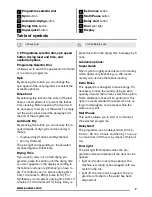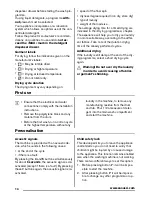
Although biodegradable, detergents contain
substances which, in large quantities, can up-
set the delicate balance of nature.
The choice of detergent will depend on the
type of fabric (delicates, woollens, cottons,
etc.), the colour, washing temperature and de-
gree of soiling.
All commonly available washing machine deter-
gents may be used in this appliance:
• powder detergents for all types of fabric
• powder detergents for delicate fabrics (60°C
max) and woollens
• liquid detergents, preferably for low tempera-
ture wash programmes (60°C max) for all
types of fabric, or special for woollens only.
The detergent and any additives must be
placed in the appropriate compartments of the
dispenser drawer before starting the wash pro-
gramme.
If using liquid detergents, a programme
with-
out
prewash must be selected.
Your appliance incorporates a recirculation sys-
tem which allows an optimal use of the concen-
trated detergent.
Follow the product manufacturer’s recommen-
dations on quantities to use and do
not ex-
ceed the «MAX» mark in the detergent
dispenser drawer
.
Quantity of detergent to be used
The type and quantity of detergent will depend
on the type of fabric, load size, degree of soiling
and hardness of the water used.
Follow the product manufacturers’ instructions
on quantities to use.
Use less detergent if:
• you are washing a small load
• the laundry is lightly soiled
• large amounts of foam form during washing.
Degrees of water hardness
Water hardness is classified in so-called “de-
grees” of hardness. Information on hardness of
the water in your area can be obtained from the
relevant water supply company, or from your lo-
cal authority. If the water hardness degree is
medium or high we suggest you to add a water
softener following always the manufacturer’s in-
structions. When the degree of hardness is
soft, readjust the quantity of the detergent.
Drying Hints
Preparing the drying cycle
As a dryer, the appliance works on the conden-
sation principle.
Therefore, the water tap must be open
and the drain hose must drain water into
a sink or into the drain pipe, even during
the drying cycle.
Attention!
Before starting the drying programme, reduce
the loads of washed laundry, in order to obtain
good performances.
Laundry not suitable for drying
• Particularly delicate items such as synthetic
curtains, woollen and silk, garments with
metal inserts, nylon stockings, bulky gar-
ments such as anoraks, bed covers, quilts,
sleeping bags and duvets must not be ma-
chine dried.
• Avoid drying dark clothes with light coloured
fluffy items such as towels as these can at-
tract the fluff.
• Remove the laundry when the appliance has
finished drying.
• To avoid a static charge when drying is com-
pleted, use either a fabric softener when you
are washing the laundry or a fabric condition-
er specifically for tumble dryers.
• Garments padded with foam-rubber or mate-
rials similar to foam-rubber must not be ma-
chine dried; they represent a fire hazard.
• Also, fabrics containing residue of setting lo-
tions or hair sprays, nail solvents or similar
solutions must not be machine dried in order
to avoid the formation of harmful vapours.
The detergent and any additives must be
placed in the appropriate compartments of the
13
www.zanussi.com














































